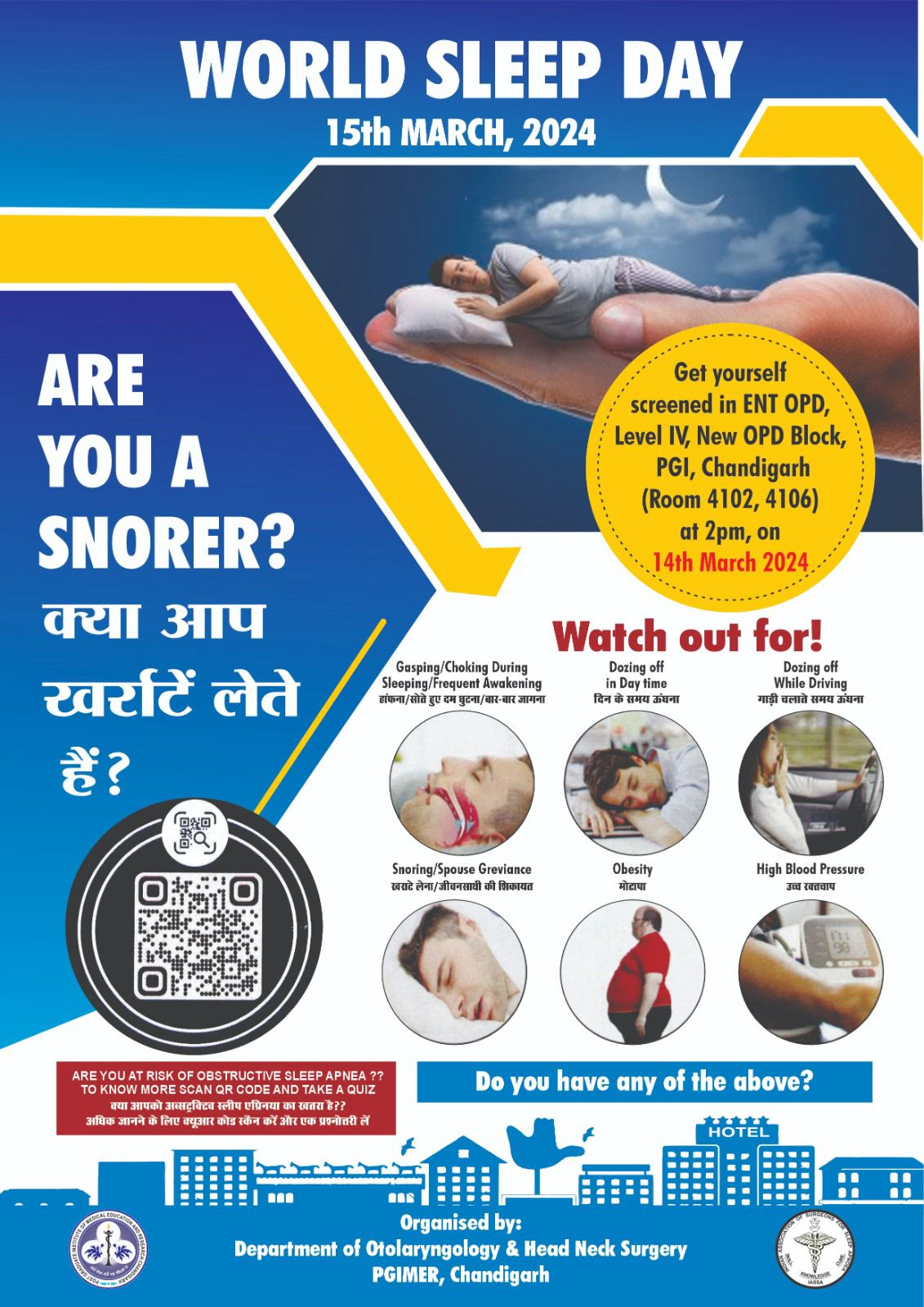
World Sleep Day March 15th,2024
Obstructive sleep apnea is a sleep disorder characterized by repetitive pauses in breathing during sleep due to the collapse of the upper airway. These interruptions in breathing can occur multiple times per hour, leading to fragmented sleep and decreased oxygen levels in the bloodstream. Common symptoms of OSA include loud snoring, daytime sleepiness, morning headaches, and difficulty concentrating.
Obstructive Sleep Apnea(OSA) directly or indirectly leads to non-communicable diseases like Hypertension, Diabetes, Cardiovascular & Neurocongnitive disorders
Obstructive sleep apnea is a sleep disorder characterized by repetitive pauses in breathing during sleep due to the collapse of the upper airway. These interruptions in breathing can occur multiple times per hour, leading to fragmented sleep and decreased oxygen levels in the bloodstream. Common symptoms of OSA include loud snoring, daytime sleepiness, morning headaches, and difficulty concentrating.
Left untreated, obstructive sleep apnea can have serious consequences on both physical and mental health. Individuals with untreated OSA are at a higher risk of developing hypertension, heart disease, stroke, diabetes, and depression. Furthermore, the impact of OSA extends beyond personal health, affecting productivity, quality of life, and imposing a significant financial burden on individuals, families, and healthcare systems.
Prof Naresh Panda, Head Department OF ENT highlighted the fact that OSA is becoming increasingly prevalent in India due to factors such as urbanization, changing lifestyles, and a rise in risk factors such as obesity and sedentary behaviour.
A study published in the Indian Journal of Sleep Medicine in 2019 estimated the prevalence of moderate to severe OSA to be around 13.7% in urban Indian population samples. Another study published in the Journal of Clinical Sleep Medicine in 2018 found a prevalence of OSA of 13.7% in a sample of middle-aged urban Indians. These findings indicate that obstructive sleep apnea is a significant health concern in India, particularly in urban areas.
Dr Sandeep Bansal, Prof. ENT said that in recent years, the prevalence of obstructive sleep apnea (OSA) has been on the rise, affecting millions worldwide. Despite its prevalence, OSA often remains undiagnosed, leading to severe health complications and financial burdens. Studies have shown that individuals with untreated OSA incur significantly higher healthcare expenses compared to those without the condition.
Early detection and effective management of obstructive sleep apnea are crucial in mitigating its adverse effects and reducing associated costs. Continuous Positive Airway Pressure (CPAP) therapy, oral appliances, lifestyle modifications, and surgical interventions are among the treatment options available for OSA. However, awareness and education are the first steps towards addressing this pervasive health issue.
In the Department of ENT in PGIMER, various studies have been conducted. One of those studies is where 72 patients with mild OSA were given a customised diet over 12 months and significant reduction in baseline energy, fat, carbohydrate intake and BMI was noted and they had significant improvement in their snoring and mild sleep apnea. An observational study was conducted in 64 patients with OSA using a questionnaire to assess their dietary habits and it was found out that though most of the patients were obese, only 3.6% of them were aware of the relation between obesity and OSA and most of them had a misconception about the type of food they consumed with a high calorie of about 40kcal/kg/day.
we encourage individuals to familiarize themselves with the signs and symptoms of obstructive sleep apnea and seek medical evaluation if they suspect they may be affected. Healthcare providers play a pivotal role in identifying and managing OSA, offering diagnostic testing and personalized treatment plans to improve patients' sleep quality and overall well-being.
Pediatric OSA
Pediatric obstructive sleep apnea (OSA) can have significant consequences on a child's health and development. Here are some of the key consequences associated with untreated pediatric OSA:
1. Impaired Growth and Development:
2. Cognitive and Behavioural Issues: Children with untreated OSA may experience cognitive deficits, including difficulties with attention, concentration, and memory. They may also exhibit behavioural issues such as hyperactivity, irritability, aggression, and poor school performance.
3. Neurobehavioral Disorders: There is evidence suggesting a link between pediatric OSA and neurobehavioral disorders such as attention deficit hyperactivity disorder (ADHD)
4. Poor Quality of Life: Pediatric OSA can negatively impact a child's quality of life and overall well-being. Daytime sleepiness, fatigue, and mood disturbances may affect social interactions, academic performance, and participation in extracurricular activities.
5. Increased Risk of Obesity: OSA and obesity often coexist in children, and one can exacerbate the other. Untreated OSA may contribute to weight gain and obesity due to disruptions in metabolic processes and alterations in appetite-regulating hormones.
6. Enuresis (Bedwetting): Children with OSA may be more prone to bedwetting (nocturnal enuresis) due to the increased pressure on the bladder caused by obstructed breathing during sleep.
7. Respiratory Problems: OSA can lead to recurrent upper respiratory infections, chronic cough, and asthma exacerbations in children. The repeated cycles of breathing pauses and oxygen desaturation can also exacerbate underlying respiratory conditions.
8. Dental and Craniofacial Abnormalities: Chronic mouth breathing, which is common in children with OSA, can lead to dental malocclusions, craniofacial changes, and alterations in facial structure over time.
Early recognition and management of pediatric OSA are essential to prevent or mitigate these consequences and promote optimal growth, development, and overall health in affected children. Treatment options may include lifestyle modifications, such as weight management and positional therapy, as well as medical interventions such as continuous positive airway pressure (CPAP) therapy or surgical procedures to address anatomical abnormalities. Regular monitoring and follow-up are crucial to ensure effective management of pediatric OSA and minimize its long-term impacts.














